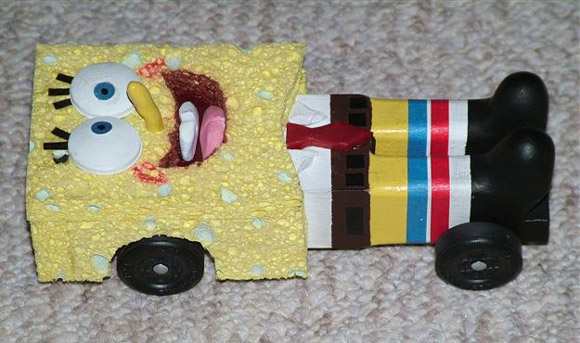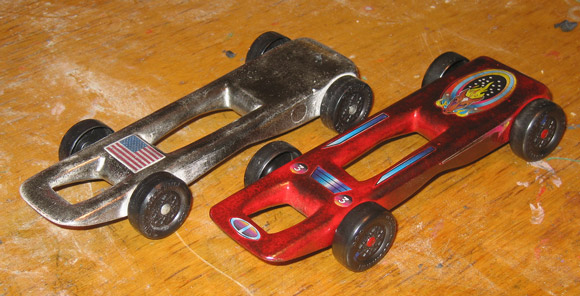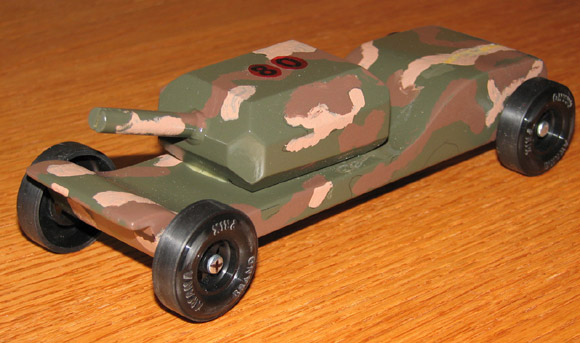– Feature Article – Utilizing Video Systems in Your Race
– Pinewood Derby Car Showcase
– Memory – You Never Know
– Q&A
Utilizing Video Systems in Your Race
By Randy Lisano
More and more race coordinators these days are using projection systems or large TVs in their races for the benefit and enjoyment of their audiences. Not only are these systems great for displaying the race results, they can also be useful before and during the race for displaying a variety of material.
First of all, you need a computer, projector, projection screen, and a cable to connect the computer to the projector. If you don’t have a portable projection screen, you can simply use a blank section of wall. However, you may need to hang up a white sheet to make the projected image easier to see.
To connect the computer to the projector, most laptops have an external monitor port and/or an S-Video port. If connecting to a TV, you can use the S-Video connection; otherwise, use a regular computer video cable to connect to a projector. Once connected, you need to output the computer’s video signal to the projector/TV. Generally, this means holding down the Function (Fn) key and then pressing one of the F keys at the top of the keyboard. If the keyboard labeling does not make it obvious, check your owner’s manual for the appropriate F key to use. You may have to push the F key several times in order to send the video signal to both your laptop screen and the projector/TV. Once you have the video connection working, everything you see on the computer screen will be displayed on the projector/TV. Now you can start utilizing the system for your audience.
Before the race you can display a photo slideshow of last year’s race (cars, racers, candid shots, etc.), show a promotional video, or information on the race. Windows gives you an easy way to do a photo slideshow. Just drop the photos into a folder on your hard drive and then use the Windows Picture and Fax Viewer program to control the slideshow. If you have video from your last race, you can show that before your race as a primer. I have also heard of someone using a video with real race footage and spectacular crashes. You can also run a PowerPoint slideshow to display race rules, list of your racers and other information.
During the race there is a lot that you can display. If you have race management software that can interface to your timer, the audience really enjoys seeing the race results as each heat is run. You can also display the final race standings and list of awards during your awards ceremony. If you have a video camera hooked up to the computer, you can even display some live action video, instant video replays1 or photo finishes2. This may also help those that cannot get a good view of the finish line to be able to see the action. Also, during the race, sometimes problems occur which cause a delay. You can use the projection system to help stall for time by distracting the audience with a funny video, or slides with derby song lyrics that they can sing along with.
The use of a projection systems or large TV can greatly enhance the enjoyment of the race for your audience, by keeping them informed of race results, entertaining them, and even by giving them an alternative view of the race action. If you have access to such a system, it is highly worth the time to setup and use.
On a final note, don’t forget to save your photos and video footage for use at your next race!
1Lisano Enterprises, developer of GrandPrix Race Manager software, also offers RaceReplay, a software package that records race video, and displays instant video replays.
2eTekGadget, makers of the SmartLine timers, offer a photo finish device and software combo.
Randy Lisano is the owner of Lisano Enterprise, makers of GrandPrix Race Manager, RaceFX and RaceReplay software, and other race products. He also maintains these race related websites:
GrandPrix Software Central
Derby Talk
Pinewood Derby Car Showcase
SpongeBob: Don Jones
This is the car I made for the adult race. He is made with a real sponge. Although he wasn’t a winner he was a kid favorite!
Twins: Dutch Weathers
In my son Jack’s first year in the pinewood derby I cut out two cars so we could build them together (his car is the red one). I showed him what to do on mine, and he did the same to his. His attention span was quite short at times, so I helped him complete some tasks. I think there are three different layers of paint because he kept changing his mind about the color. When race day came, he was ecstatic; his car came in first out of all the Tigers. Here in Bergen County, New Jersey, the Tigers have their own race in the Regionals. We had a bit of a problem here because the Regionals require that all four wheels touch the ground. So we had to fill in the axle hole and drill a new one. We made the change, and his car went on to win the Regionals. Something that surprised me was how much faster my car was than his. We used my car as the prototype, and used the best wheels and axles on his car. The wheels on my car were a lot sloppier on the axles than his, they wobbled a lot when spun. We didn’t have a test track, so we didn’t find out my car was faster until I raced his after the derby was over.
Tank: Jon Joslin
My son Tommy and I have been working on our first Awana car since our Christmas break. I ordered your booklet of suggestions for making a derby car in early December, then I ordered several of your speed products. Tommy wanted to paint the car ‘camo’ colors, so we decided on the tank design. Being our first project, we have spent many hours already, and still have a ways to go. Melting and pouring lead into holes in the back of the car has been the most challenging part, but we were successful in obtaining 5.03 oz on an electronic balance with the COG about 1.75″ in front of the back axle. Our derby is in February, so we still have time to polish and lubricate the axles, and go through the alignment process. We are looking forward to the final event in February, and have already started making plans for next year’s design.
Editor’s Note: We strongly recommend not melting lead, as it is a potentially dangerous practice.
Pinewood Derby Memory
You Never Know
My Son, Zachary is now a Webelo 1. We have been racing Pinewood Derby in our Pack since he was a Tiger. His first race was a heart breaker to say the least. His car came in third out of three cars! But, he got to go on to the District race because the top three from each Den gets to go.
The car was a disaster from the beginning. We used a standard Cub Scout block, and I just about cut off a finger trying to work on it! We had the wrong kind of paint, and had to put it on the stove to get the paint to dry, since we didn’t get it finished till the night before the race.
Before the District race, we had some more time to work on it. Well, the extra work didn’t do anything but make it run slower. It barely made it to the finish line! We were both heart broken, and he looked at me as if to say, “What happened former Cub Scout, Eagle Scout, now Den Leader?” I just told him that we learned from our mistakes, and we would work harder next year.
The next year he was a Wolf. This year we bought a kit instead of using the Cub Scout block, but we used the official BSA wheels from the official kit. We put the weight inside the car, which was a rail type. The night before the race while we where helping set up the track it ran fantastic! But the day of the race, we found out it was way too light. So, we added weight to the back. Well again, he came in last. I believe that adding the extra weight at the last minute threw off the balance of the car. I had put it towards the back.
So last year, we went with the rail type kit again. But instead of putting the weight inside, we got the weights that go across the full bottom of the car. I took a few off just in case it was over weight, but could add on at the last minute if need be. It came in at 5 oz. exactly.
Needless to say, he came in first in his Den, and third in the Pack. Then third in the District race a few weeks later. We where both very happy campers after that.
Funny thing is, the Cub who came in first in the Pack had hardly done any work on his car. He stood at the weigh-in putting washer’s on his car until it got to 5 ounces. Then he taped them on with masking tape!!! He didn’t place at District, but still! Like I told my son, it just goes to show you, you just never know how your car is going to run.
Our Pack race is going to be at the end of January this year. We are again going with the rail-type. I’ll let you know how we do!
Don Hoard
Cubmaster, Pack 202 in Greenbelt, Maryland
Q&A
Has anyone ever done a study on lifting a rear wheel instead of a front wheel?
Generally, cars perform better with the weight shifted to the rear of the car. If you raise a rear wheel, the car will rock towards the raised wheel, resulting in the car running with the nose angled upward. Thus, the front wheel is always raised (on a rear-weighted car).
We are looking to build a chamber inside a pinewood derby car. The chamber would be larger in the back, smaller in the front, and long enough for the powder to flow back and forth. Tungsten powder would fill the back of the chamber, and as the car tilts to the downward position the powder would flow towards the front of the car, giving it an extra push. Would this work?
The tungsten powder would flow as you suggest. However, I don’t recommend doing this for two reasons:
- Most rules require all parts to be firmly secured. Moveable weight is typically disallowed.
- More importantly, having the weight shift to the front of the car on the incline will slow the car down. Best speed is achieved with the weight towards the rear of the car. The goal is to have the balance point of the car located at about 3/4 and 1 inch in front of the rear axle.
Some advantage might be gained if the weight was located at the rear while the car negotiated the slope and transition, and then the weight moved to the middle while the car was on the flat. This would equalize the load on the wheels (this assumes a four-wheel-on-the-ground car), allowing the car to maintain speed for a longer period time. But of course, a setup that would move the weight in this manner would still violate the moveable weight rule.
I am using a 3000 grit paper to polish axles. The axles are always leaving a black mark on the sandpaper, which seems odd. No matter how much I polish them, they always leave marks on the paper. Is this normal?
Polishing involves removing increasingly smaller particles of material from the axles, resulting in a smoother finish. What you are seeing on the polishing paper is the axle material (zinc, nickel, or steel) that is being removed. As long as you keep polishing, material will continue to be removed, leaving black marks on the paper.
Want Answers?
Do you have a pinewood derby-related question? If so, e-mail us your question.We answer all questions by e-mail, but not every question will appear in the Q&A section of the newsletter.
Back Issues
Are you a new subscriber, or have you missed some of the previous newsletters? Don’t miss out; all of the issues for Volume 5 through Volume 17 are posted on our web site.
Newsletter Contributions
We welcome your contributions. If you would like to contribute an article, a web site review, a speed tip, or a pinewood derby memory, please e-mail us.
Subscription Information
The Pinewood Derby Times is a free e-newsletter focused on pinewood derby racing. It is published biweekly from October through March.
If you haven’t already done so, please forward this issue to your pinewood derby friends. But please don’t subscribe your friends. Let them decide for themselves. Thanks.
If this newsletter was forwarded to you, why not subscribe to receive this newsletter. There is no cost, and your e-mail address is safe, as we never sell or share our distribution list.
To subscribe, send a blank e-mail to
[email protected]
You will receive a confirmation e-mail. Reply to the confirmation e-mail and you will start receiving the Pinewood Derby Times with the next issue.
Randy Davis, Editor, Pinewood Derby Times
E-Mail: [email protected]
(C)2018, Maximum Velocity, Inc. All rights reserved. Please do not reprint or place this newsletter on your web site without explicit permission. However, if you like this newsletter we grant permission, and encourage you to e-mail it to a friend.
Maximum Velocity disclaims any personal loss or liability caused by utilization of any information presented in this newsletter.
The Pinewood Derby Times is not specific to, and is not affiliated with the Boy Scouts of America, YMCA, Awana, or any other organization.
(R)Maximum Velocity is a registered trademark of Maximum Velocity, Inc.
(R)Pinewood Derby is a registered trademarks of the Boys Scouts of America.
(R)Awana is a registered trademark of Awana Clubs International.
All other names are trademarks of their respective owners.



